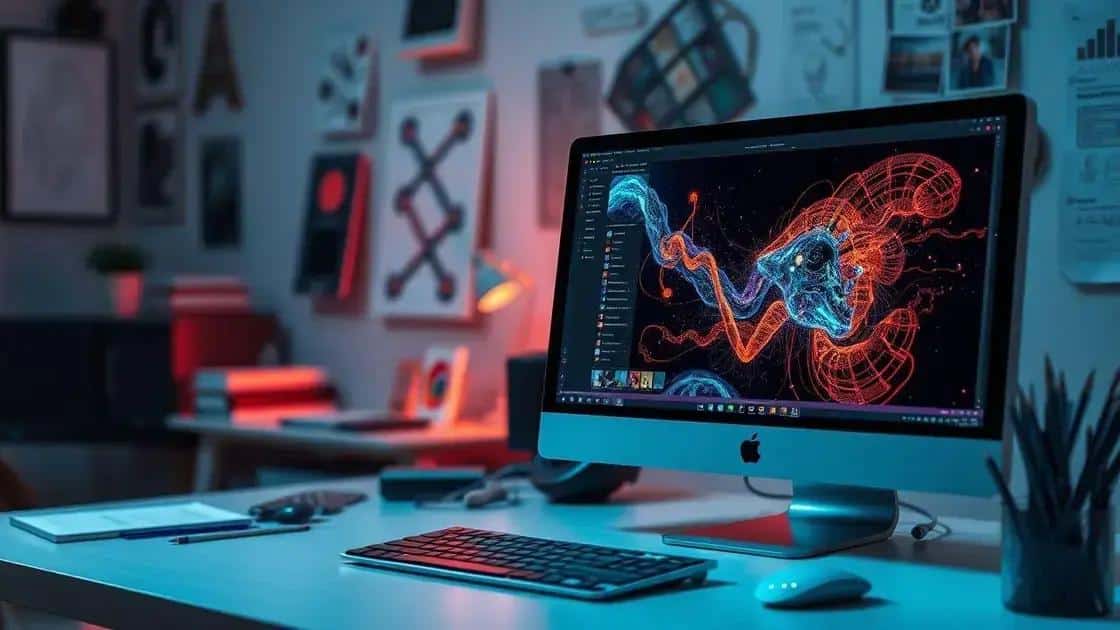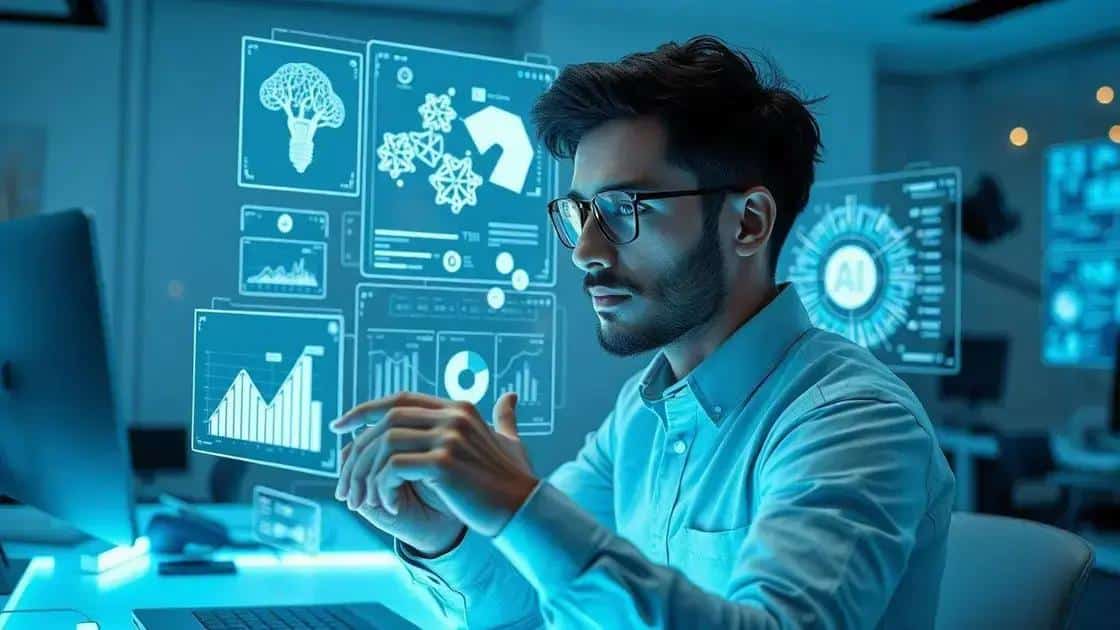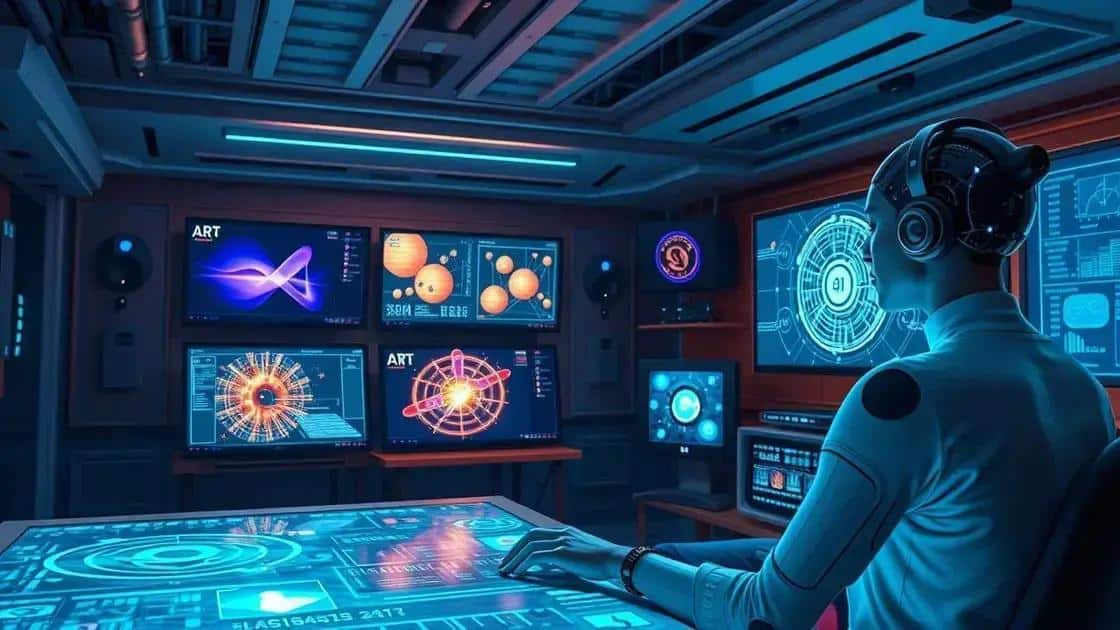AI-generated media trends shaping the future

AI in creative industries is revolutionizing how art, music, and media are produced, enabling enhanced collaboration between technology and artists while personalizing user experiences through data analysis.
AI-generated media trends are evolving rapidly, influencing how we perceive and create content. Have you noticed the increasing use of AI in everything from visual arts to video production? Let’s dive into what these trends mean for the future.
Understanding AI-generated media
Understanding AI-generated media is essential for anyone interested in the future of digital content. This technology is reshaping how we create and consume various forms of media, from artwork to music. By leveraging advanced algorithms, AI can produce content that almost mimics human creativity.
What is AI-generated media?
AI-generated media refers to any content produced with the help of artificial intelligence software. This includes images, videos, music, and texts created through machine learning techniques. With AI tools, creators can explore new avenues of expression that were once thought impossible.
How does AI impact content creation?
The impact of AI on content creation is profound. For example, artists can use AI to enhance their work, generating fresh ideas through machine suggestions. Notably, AI can analyze trends and audience preferences, leading to more engaging content. Here are a few significant benefits:
- A faster production process, allowing creators to focus on storytelling.
- The ability to customize content to meet audience needs effectively.
- New tools that help artists push creative boundaries.
Moreover, AI can generate media that adapts in real-time. This adaptability offers personalized experiences tailored to individual users, making content more relevant and engaging. In summary, understanding AI-generated media means recognizing its potential not just as a tool but as a collaborator in the creative process.
Impact of AI on content creation

The impact of AI on content creation is transforming various creative fields. With advanced algorithms, AI tools can enhance creativity and streamline the production process. Many creators are discovering that these technologies can act as valuable partners in their work.
How AI is changing the landscape
AI is making waves in the way content is developed. From video editing to graphic design, this technology enables faster and more efficient workflows. In many cases, AI can generate initial drafts, allowing artists to refine their ideas. This leads to innovation and sparks unique artistic expressions.
Key benefits of using AI tools
AI tools come with several advantages that make content creation more dynamic. Here are some notable benefits:
- Increased efficiency in the creation process.
- Greater ability to analyze audience preferences.
- Enhanced collaboration between human artists and AI.
Moreover, AI can analyze large datasets to predict trends, ensuring that creators stay ahead of the curve. This predictive capability helps them to produce content that resonates better with their audience. The collaboration between humans and AI not only saves time but also fosters a new wave of creativity.
As we delve deeper into the world of AI, it becomes clear that its impact on content creation is profound. By embracing these technologies, artists and creators can explore untapped potential and bring their visions to life in innovative ways.
Trends in AI-generated visuals
Trends in AI-generated visuals are rapidly evolving, reshaping how we view and interact with digital art and design. These trends reveal not just advancements in technology but also shifts in creative expression.
The rise of generative art
Generative art is becoming increasingly popular, enabling artists to create unique pieces using algorithms. Artists can write rules that guide the AI, resulting in innovative designs that blend human creativity with machine efficiency. This practice encourages collaboration between humans and AI, leading to fascinating outcomes that challenge traditional art forms.
Enhancements in image quality
AI tools have significantly improved the quality of visuals being generated. With advancements in deep learning, images can now appear more realistic than ever. By understanding intricate details, AI learns to depict textures, colors, and shadows, creating stunning visuals that almost resemble photographs.
- Utilization of neural networks to enhance image clarity.
- Ability to generate high-definition graphics suitable for various applications.
- Integration of user feedback to refine visual outputs.
Furthermore, the incorporation of AI-generated visuals into marketing is a notable trend. Businesses are utilizing these visuals for everything from social media ads to website design, ensuring a contemporary and engaging presence. As a result, companies can stand out in a crowded marketplace, capturing consumer attention with eye-catching AI-created imagery.
In the realm of design, AI is helping creators experiment with styles and themes inexpensively. Artists are now able to iterate on their concepts in a fraction of the time, allowing for greater exploration and innovation. The intersection of technology and art is fostering a creative revolution, with trends in AI-generated visuals paving the way for the future of digital content.
Future of AI in creative industries

The future of AI in creative industries is bright and full of potential. As technology continues to develop, AI’s role in creativity will expand, influencing various fields such as art, music, and design.
Emerging collaborations between humans and AI
One exciting aspect of this future is the collaboration between artists and AI. Creators can harness AI tools to explore new forms of expression that were previously unimaginable. For instance, musicians might use AI to generate unique melodies or rhythms, while visual artists could rely on algorithms to brainstorm innovative concepts.
Personalization and user engagement
The capability of AI to analyze data will enhance personalization in creative outputs. By understanding audience preferences, AI can help deliver tailored content that resonates more deeply with viewers and listeners. This has significant implications for marketing, entertainment, and education, as customized experiences become the norm.
- AI can create targeted advertisements that engage specific demographics.
- Personalized recommendations in streaming services will enhance user experience.
- Interactive installations can change based on audience reactions through AI algorithms.
As we look ahead, the landscape of creative industries will likely face challenges too. Issues regarding copyright and ownership of AI-generated content need to be addressed. As these technologies evolve, regulations must emerge to protect artists’ rights and foster a fair environment for collaboration.
Additionally, while AI can assist in the creative process, it’s important to remember the unique value of human creativity. Technologies will complement human efforts rather than replace them. The future of AI in creative industries promises a new era where technology enhances art, leading to groundbreaking works that inspire and captivate audiences.
FAQ – Frequently Asked Questions about AI in Creative Industries
What role does AI play in modern art creation?
AI serves as a collaborative tool that helps artists explore new forms of artistry, generating unique ideas and enhancing traditional techniques.
How does AI enhance user engagement in creative content?
AI analyzes user data to customize experiences, making content more relevant to individual preferences, thus improving engagement.
What are the potential challenges of using AI in creativity?
Challenges include copyright issues and the need for regulations to address ownership of AI-generated content.
Will AI replace human creativity?
AI is designed to complement human creativity, not replace it, allowing creators to focus on innovative expressions while AI handles repetitive tasks.





